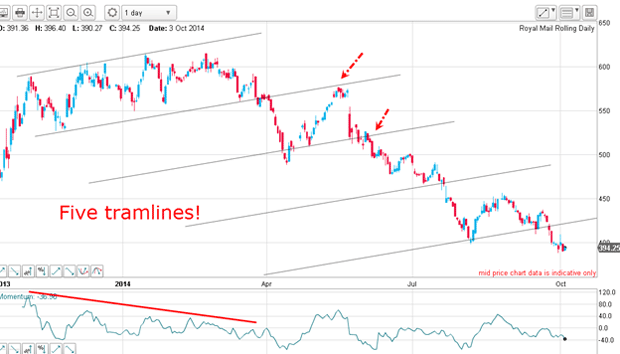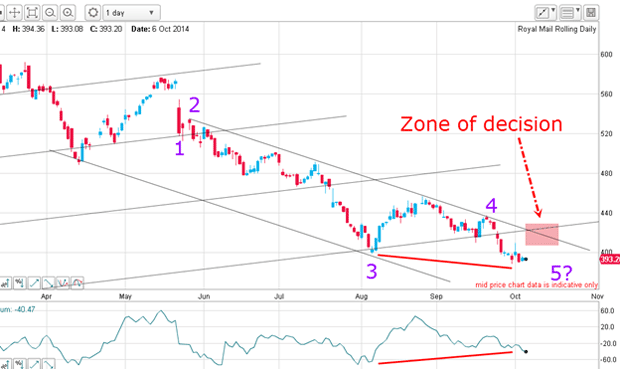Was Royal Mail's IPO really too cheap?
Royal Mail's share price chart shows why it pays to use a trading system that's independent of politics. John C Burford explains.
Remember the political furor surrounding the Royal Mail float last year? The accusation was that the government's advisors had deliberately ensured the issue price was low (330p), so that they could clean up in the inevitable initial public offering (IPO) scramble.
In fact, on issue day, 11 October, shares made an historic rise of 48% to the 455p level. Predictably, Vince Cable, the UK business secretary, was hauled over the coals in a ritual grilling by MPs who accused Cable of robbing the UK taxpayer' of those gains.
Here we are, a year later, and with the benefit of hindsight, can we now answer that question?
MoneyWeek
Subscribe to MoneyWeek today and get your first six magazine issues absolutely FREE

Sign up to Money Morning
Don't miss the latest investment and personal finances news, market analysis, plus money-saving tips with our free twice-daily newsletter
Don't miss the latest investment and personal finances news, market analysis, plus money-saving tips with our free twice-daily newsletter
As you know, I rarely cover an individual share in these posts. But the Royal Mail chart is so compelling that it is an object lesson in why it pays to use a system in trading that is independent of politics, or any other outside influence.
And that applies to investors as well as traders. As an investor, I do not believe in holding a share that is not performing. It is just as important to get your timing right in long-term positions as it is for swing trading.
Of course, if attracted to the IPO initially, you would be making a decision based purely on the prospects for the newly-liberated company. No chart-based system could be applied there was no chart!
But if you have invested, it would pay to keep track of the chart as it developed, as I will show.
Why it pays to keep track of chart developments
Here is the daily chart since launch:

The initial enthusiasm for the shares turned into a stepwise progression up into 2014. It was then that I could start to place tentative tramlines and anticipate a topping process, given the huge momentum divergence that was developing.
In March, I could firm up my first two tramlines and when the lower tramline was broken, it confirmed to me that a top of some kind had been formed. That was a very sensible place to liquidate positions (in the 550 area). It was also a good place for traders to enter short trades, following my tramline trading rule.
Note that I had confidence in my upper tramlines where I had four accurate touch points on the upper line and two touch points on the lower line.
The market did rally after that and planted a textbook kiss (red arrow) before peeling away. That was another excellent short trade entry.
Note that both possible entries were at low risk where protective stops could be placed quite close to entries.
An easy way to guide your trades
With the tramline break, I could then draw my third tramline and the fourth - and the fifth. With the break of the third tramline, the target was the fourth and after a small relief bounce off it, it broke that and proceeded to head for the fifth tramline. Note the strong bounce off this line, confirming it as a line of support.
But the selling was too much and last week, that tramline was broken.
What a wonderful example of how tramlines can pinpoint areas of support in a down market. I strongly advise investors as well as traders to use this simple device to guide your trades.
Now, with the market having lost around 30% since getting the sell signal at 550, an investor would have the option of either waiting for a buy signal in Royal Mail if one appears, that is or sitting with cash in the bank.
Anyone still holding would be suffering that loss and probably be thinking it has fallen too far to sell. This is what makes bear markets! And for most investors, they only sell out when they throw in the towel emotionally and at much lower prices.
That would be the time for the astute investor, who sold out at 550, to pick up some cheap shares.
Was Royal Mail sold off too cheaply?
So what would be a valid buy signal using my tramline methods?

The move off the May high is following along my lovely tramlines where the upper line has multiple accurate touch points. Also, I can set my Elliott wave labels as shown. The third wave is long and strong, as required. And to cap it off, there is a large positive-momentum divergence brewing. Hmm.
Naturally, it is too soon to call the bottom as fifth waves can extend much lower. But if the market can rally, it would enter my zone of decision and either plant a kiss with a scalded-cat bounce down, or zoom upwards breaking my upper tramline.
We shall soon see which scenario plays out.
The bottom line is that you can use this kind of analysis whether you are an investor and/or a trader.
So, was Royal Mail sold off too cheaply? To me, it doesn't matter all I am interested in is this: is there a profitable trade here?
Get the latest financial news, insights and expert analysis from our award-winning MoneyWeek team, to help you understand what really matters when it comes to your finances.
John is is a British-born lapsed PhD physicist, who previously worked for Nasa on the Mars exploration team. He is a former commodity trading advisor with the US Commodities Futures Trading Commission, and worked in a boutique futures house in California in the 1980s.
He was a partner in one of the first futures newsletter advisory services, based in Washington DC, specialising in pork bellies and currencies. John is primarily a chart-reading trader, having cut his trading teeth in the days before PCs.
As well as his work in the financial world, he has launched, run and sold several 'real' businesses producing 'real' products.
-
 How cancelling unused direct debits could boost your pension by £37,000
How cancelling unused direct debits could boost your pension by £37,000A new year refresh of your spending could save you money and help boost your pension pot.
-
 NS&I cuts interest rates on 8 savings accounts
NS&I cuts interest rates on 8 savings accountsNS&I will now offer less attractive interest rates for customers wishing to lock their savings away to grow for one, two, three or five years.
